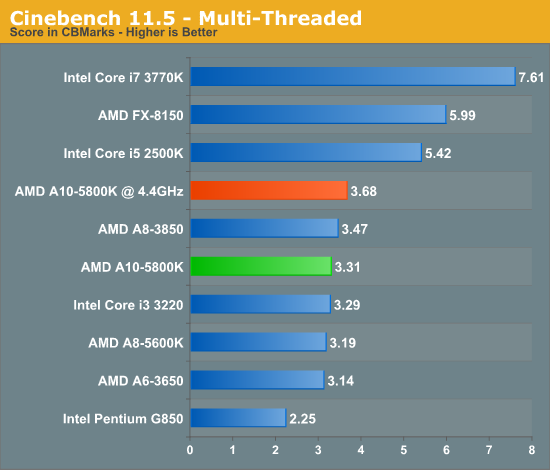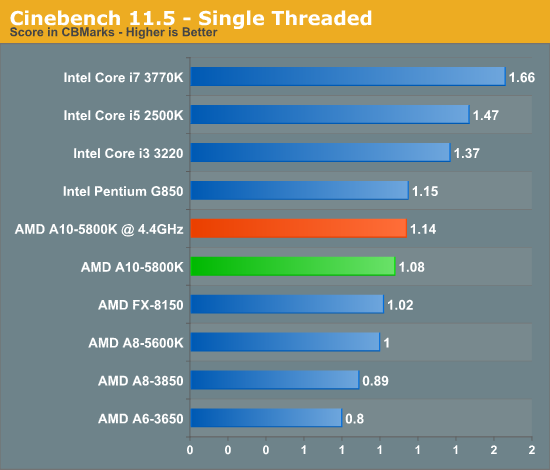AMD A10-5800K & A8-5600K Review: Trinity on the Desktop, Part 2
by Anand Lal Shimpi on October 2, 2012 1:45 AM ESTOverclocking
With Sandy Bridge Intel killed budget overclocking by completely clock locking all CPUs without turbo boost enabled. While you used to be able to buy an entry level CPU and overclock it quite nicely, Intel moved all overclocking to its higher priced parts. As a gift to the overclocking community, Intel ramped up the presence of its fully unlocked K-series parts. Anything with a K at the end shipped with a fully unlocked clock multiplier, at a small price premium. Given that Intel hadn't shipped unlocked CPUs since the days of the original Pentium, this was a welcome move on its part. What would really be nice is the addition of some lower priced K SKUs, unfortunatley we won't get that unless there's significant competitive pressure from AMD.
Trinity doesn't have what it takes to really force Intel into doing such a thing, but that doesn't mean AMD won't try. The Trinity lineup includes AMD's own K-series SKUs that, like their Intel counterparts, ship fully unlocked. From $67 all the way up to $122, AMD is offering unlocked Trinity APUs. The value of these parts really depends on just how overclockable Trinity is to begin with. The Bulldozer/Piledriver architecture is designed to push frequency, however AMD is already shipping these things at very close to 4GHz to begin with. Take AMD's turbo frequencies into account and you're already at 4.2GHz with the A10-5800K. How much additional headroom is there?

With a stock cooler and not a ton of additional voltage, it looks like there's another 5 - 15% depending on whether you're comparing base clocks or max turbo clocks. With an extra 0.125V (above the 1.45V standard core voltage setting) I was able to hit 4.4GHz on the A10-5800K. I could boot into Windows at 4.5GHz however the system wasn't stable. Although I could post at 4.6GHz, Windows was highly unstable at that frequency. With more exotic cooling I do believe I could probably make 4.5 work on the A10-5800K.

The extra frequency isn't enough to erase the single threaded performance gap between the A10 and Intel's Core i3 3220 however:

The only way AMD is going to close this gap is through a serious focus on improving single threaded performance in future architectures.










178 Comments
View All Comments
Aone - Wednesday, October 3, 2012 - link
Who being in his right buys high-end discrete GPU for cheap CPU or APU?Plus, those who buy cheap CPUs usually don't have money for high-end discrete GPU.
Gaugamela - Wednesday, October 3, 2012 - link
Here are benchmarks that test the importance of faster RAM in these APUs. The difference in performance is astonishing. http://hexus.net/tech/reviews/cpu/46073-amd-a10-58...By overclocking and using 2133Mhz RAM the A10-5800 can get approximately a 30% increase in 3DMark and some games.
These Trinity APUs seem to be really interesting to tinker with.
creed3020 - Wednesday, October 3, 2012 - link
Thanks so much for posting that. I've been looking for this exact testing of Trinity. AT did this previously with Llano but forgot this crucial test with Trinity.It really helps system builders to set expectations for performance if a client doesn't want to pay for faster memory, or if they do want more performance we can quantify how much an improvement faster memory will have.
mikato - Wednesday, October 3, 2012 - link
Holy molyvozmem - Wednesday, October 3, 2012 - link
Keep encouraging AMD, guys.rarson - Wednesday, October 3, 2012 - link
Why in the world did you not mention which video card you were using on this page? I see that it's mentioned in the test bed, but why the heck do I have to go back and check that when you could have easily mentioned it on the discrete test page?Also, why are you using a 5870 with this? Who the hell is going to pair a new A8 or A10 Trinity with a 5870? That's completely illogical. Couldn't you have tried something newer, perhaps something within the same architecture? Extremely puzzling.
etamin - Wednesday, October 3, 2012 - link
And why was an FX-8150 thrown into the DISCRETE PROCESSOR GRAPHICS benchmark?Hardcore69 - Wednesday, October 3, 2012 - link
HA! Glad I went with an i3 3220 for this office box. Look at the power consumption at load, look at the single threaded benchmarks, even look at the multi threaded benchmarks. AMD is crap. It still hasn't caught up. And there are very few upgrade options compared to Intel. If you want to play games, a dedicated GPU is still vastly better. For other basic tasks, FAIL.rarson - Wednesday, October 3, 2012 - link
You paid more money.They're called trade-offs. That's reality.
Nil Einne - Friday, October 5, 2012 - link
Has anyone come across real world power consumption figures for either the A8-5500 vs A8-5600K or the A10-5700 vs A10-5800K. These have different TDPs, 65W vs 100W and slightly different clocks. But I'm wondering whether the K ones are really that bad in general or it's partially that they wanted more headroom since the K ones are to some extent designed to be overclocked. Of course the different ratings means that you may get unlucky and get a fairly high consumption K processor because of binning but still may be relevent. I'm somewhat out of date and not familiar with how turbo works, but I'm guessing the higher binning means it will stay at turbo for longer so a proper test should also try limiting the K to be the same as the non K just to see if that's the primary reason for any differences. (Ideally also limit the frequencies.)Most reviews including this one seem to be of the Ks I presume because that's what AMD sent out for testing.
Cheers